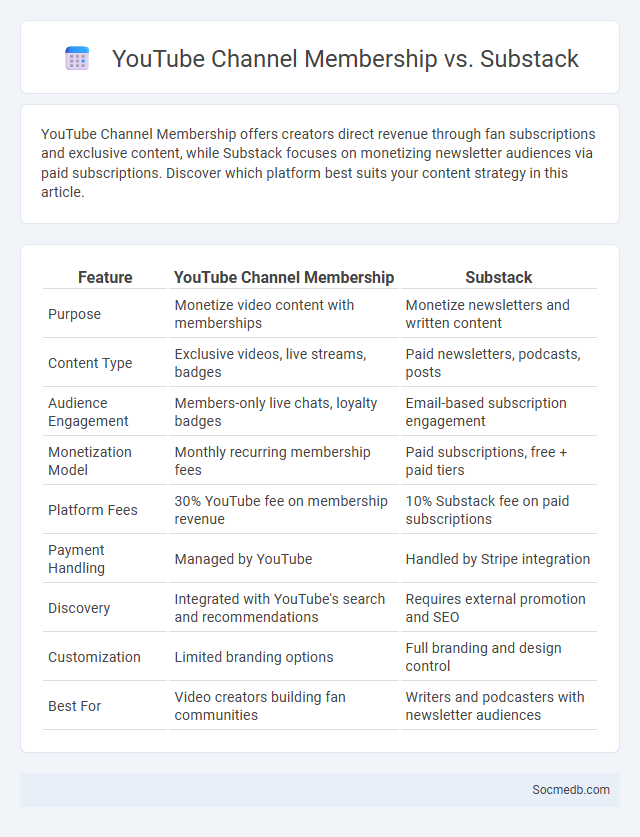
Photo illustration: YouTube Channel Membership vs Substack
YouTube Channel Membership offers creators direct revenue through fan subscriptions and exclusive content, while Substack focuses on monetizing newsletter audiences via paid subscriptions. Discover which platform best suits your content strategy in this article.
Table of Comparison
| Feature | YouTube Channel Membership | Substack |
|---|---|---|
| Purpose | Monetize video content with memberships | Monetize newsletters and written content |
| Content Type | Exclusive videos, live streams, badges | Paid newsletters, podcasts, posts |
| Audience Engagement | Members-only live chats, loyalty badges | Email-based subscription engagement |
| Monetization Model | Monthly recurring membership fees | Paid subscriptions, free + paid tiers |
| Platform Fees | 30% YouTube fee on membership revenue | 10% Substack fee on paid subscriptions |
| Payment Handling | Managed by YouTube | Handled by Stripe integration |
| Discovery | Integrated with YouTube's search and recommendations | Requires external promotion and SEO |
| Customization | Limited branding options | Full branding and design control |
| Best For | Video creators building fan communities | Writers and podcasters with newsletter audiences |
Understanding YouTube Channel Membership
YouTube Channel Membership offers creators a revenue stream by allowing subscribers to pay a monthly fee for exclusive perks like badges, emojis, and members-only videos. This feature enhances viewer engagement by fostering a sense of community and loyalty among fans. Creators can customize membership tiers to provide varied access and rewards, optimizing both audience retention and monetization.
What Is Substack and How Does It Work?
Substack is a subscription-based platform that enables writers to publish newsletters directly to their audience while monetizing content through paid subscriptions. It operates by allowing creators to build email lists, distribute content via email and web, and manage payments seamlessly. The platform integrates features like analytics, subscriber management, and customizable design, making it a popular tool for independent journalists and content creators seeking direct reader support.
Channel Membership: Platform Comparisons
Channel membership features vary significantly across social media platforms, with YouTube offering the most robust options including tiered memberships and exclusive content access, fostering stronger creator-audience connections. Facebook provides fan subscriptions with perks like exclusive posts and badges, while Instagram's similar features remain limited and less developed. Your choice should consider platform demographics and the available tools for subscriber management and direct engagement to maximize revenue and community building.
Content Monetization: YouTube vs Substack vs Alternatives
Content monetization on social media platforms varies significantly, with YouTube offering ad revenue sharing and Super Chat features, while Substack enables direct subscription-based income through newsletters. Alternatives such as Patreon and TikTok also provide diverse monetization options including memberships, tips, and creator funds, catering to different content formats and audience engagement strategies. Choosing the right platform depends on the creator's content type, audience demographics, and preferred revenue models to maximize earnings.
Audience Engagement: Which Platform Wins?
Facebook leads in audience engagement with its diverse tools like groups, live videos, and targeted ads, fostering deeper interactions. Instagram excels in visual storytelling and influencer partnerships, driving high engagement rates among younger demographics. Understanding Your audience's preferences on these platforms can maximize engagement and ROI.
Revenue Streams and Payout Models
Social media platforms generate revenue primarily through advertising, influencer partnerships, subscription services, and sponsored content, driving billions in global revenue annually. Payout models typically include revenue sharing, fixed fees, and performance-based incentives, ensuring creators and advertisers are compensated based on engagement and reach. Understanding these revenue streams helps you optimize content strategies for maximum financial return.
Ease of Use for Creators
Social media platforms prioritize intuitive interfaces that allow creators to quickly produce and share content without technical barriers. Tools such as drag-and-drop editors, customizable templates, and real-time analytics simplify content management and engagement tracking. Your experience as a creator is enhanced by streamlined workflows that encourage creativity and consistent audience interaction.
Community Building Features Compared
Social media platforms such as Facebook, Reddit, and Discord offer diverse community-building features tailored to user engagement and interaction. Facebook Groups provide structured environments for discussions, events, and file sharing, fostering close-knit communities. Reddit's subreddit model allows niche audience targeting with upvote/downvote systems, while Discord emphasizes real-time voice, video, and text communication for dynamic community collaboration.
Managing Content and Exclusive Perks
Managing content on social media requires a strategic approach to scheduling posts, monitoring engagement metrics, and maintaining brand consistency across platforms. Leveraging exclusive perks such as early access to new products, members-only discounts, and personalized content can significantly boost follower loyalty and drive user interaction. Implementing tools like content calendars and analytics dashboards enhances efficiency and maximizes the impact of exclusive offers on audience growth.
Choosing the Right Platform for Your Needs
Selecting the ideal social media platform depends on your target audience, content type, and business goals. Instagram excels in visual storytelling for lifestyle and fashion brands, while LinkedIn is preferred for B2B marketing and professional networking. Analyzing user demographics, engagement rates, and platform features ensures your social media strategy effectively reaches and resonates with your intended audience.
 socmedb.com
socmedb.com